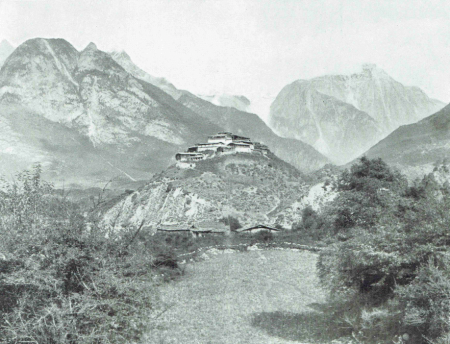Yuri Monastery: Difference between revisions
Yeshedorje (talk | contribs) m (→Developments) |
Yeshedorje (talk | contribs) m (→Main practices) |
||
| Line 24: | Line 24: | ||
In the 1930’s, [[Dorje Drakpa]] invited Dudjom Rinpoche to grant the Rinchen Terdzö empowerments in Yuri Monastery. Among the participants were Dorje Drakpa and [[Togden Kunzang Longrol]].<Ref>Emeric Yeshe Dorje, The History of the Düdjom Tersar, forthcoming.</Ref> | In the 1930’s, [[Dorje Drakpa]] invited Dudjom Rinpoche to grant the Rinchen Terdzö empowerments in Yuri Monastery. Among the participants were Dorje Drakpa and [[Togden Kunzang Longrol]].<Ref>Emeric Yeshe Dorje, The History of the Düdjom Tersar, forthcoming.</Ref> | ||
==Main | ==Main Practices== | ||
The main practices are [[Mahamudra]], [[Six Yogas of Naropa]], [[Chakrasamvara]], [[Vajravarahi]], following the tradition of the Karma Kagyü.<Ref>Phurbu rdo rje (1988), sPo bo lo rgyus, [History of Powo], Lhasa: Bod ljongs mi dmangs dpe skrun khang.</Ref> | The main practices are [[Mahamudra]], [[Six Yogas of Naropa]], [[Chakrasamvara]], [[Vajravarahi]], following the tradition of the Karma Kagyü.<Ref>Phurbu rdo rje (1988), sPo bo lo rgyus, [History of Powo], Lhasa: Bod ljongs mi dmangs dpe skrun khang.</Ref> | ||
Revision as of 14:29, 23 March 2021

Yuri Monastery, aka Yuri Trashi Rabten Ling (Wyl. gyu ri bkra shis rab brtan gling) is a main Karma Kagyü monastery in northern Powo.
Location
Yuri Tashi Rabten Ling is located in northern Powo (Upper Powo, aka Potö) on the upper banks of the Potö Chu, before it joins the Parlung Tsangpo at the town of Kanam. [1]
In the sacred geography of Tibet being mapped as the inner body of the Queen of Space (Yingchugma), Khachö Yuri represents the navel chakra, the aspect of enlightened qualities.
Foundation
Yuri Tashi Rabten Ling was established in the 17th century by the Tenth Karmapa, Chöying Dorje, (1604-1674). Earlier, the place has been visited by Gyatön Jigme Drakpa (Wyl. brgya ston ‘jigs med grags pa).[2]
Developments
From 1604 to 1981, being under the guidance of the Karmapas
Yuri Monastery was under the direct guidance of the Karmapas from the Tenth to the 16th incarnation. But there was also a tradition of establishing smaller scale monastic institutions around Yuri Monatery [3] Headmasters of other monasteries located close to Yuri Monastery includes: *Chödrak Yeshe, (Wyl. chos grags ye shes), The Fourth Shamarpa, (1453–1524).
- Könchok Yenlak, (Wyl. dkon mchog yan lag), The Fifth Shamarpa, (1525–1583).
- Garwang Chökyi Wangchuk (Wyl. gar dbang chos kyi dbang phyug), The Sixth Shamarpa, (1584–1630).
Likely in the late 15th century, Shamar Chökyi Drakpa (Wyl. shwa dmar chos kyi grags pa), The Eight Shamarpa, (1453 -1524), founded the monastery of Yuri Lingdruk (Wyl. g.yu ri gling drug) at the same place. At the same time, Sherab Drakpa established Dralpang Kar Gön (Wyl. ‘phral spang dkar dgon) along with a hermitage and a retreat center. [4]
At times, Yuri Monastery housed between 40 and 50 monks.
In the 1930’s, Dudjom Rinpoche granting the Rinchen Terdzö
In the 1930’s, Dorje Drakpa invited Dudjom Rinpoche to grant the Rinchen Terdzö empowerments in Yuri Monastery. Among the participants were Dorje Drakpa and Togden Kunzang Longrol.[5]
Main Practices
The main practices are Mahamudra, Six Yogas of Naropa, Chakrasamvara, Vajravarahi, following the tradition of the Karma Kagyü.[6]
Main Teachers
The main teachers were the Karmapa and the Shamarpa.
Internal Links
Notes
- ↑ Emeric Yeshe Dorje, The History of the Düdjom Tersar, forthcoming.
- ↑ Phurbu rdo rje (1988), sPo bo lo rgyus, [History of Powo], Lhasa: Bod ljongs mi dmangs dpe skrun khang.
- ↑ Phurbu rdo rje (1988), sPo bo lo rgyus, [History of Powo], Lhasa: Bod ljongs mi dmangs dpe skrun khang.
- ↑ Phurbu rdo rje (1988), sPo bo lo rgyus, [History of Powo], Lhasa: Bod ljongs mi dmangs dpe skrun khang.
- ↑ Emeric Yeshe Dorje, The History of the Düdjom Tersar, forthcoming.
- ↑ Phurbu rdo rje (1988), sPo bo lo rgyus, [History of Powo], Lhasa: Bod ljongs mi dmangs dpe skrun khang.